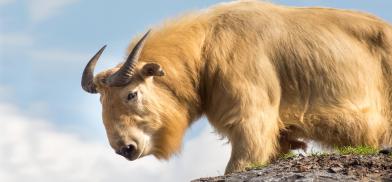The tale of the obscure takin, Bhutan’s national animal
Have you ever seen a takin? Chances are an overwhelming majority of people will meet the poser with a baffled look

Have you ever seen a takin? Chances are an overwhelming majority of people will meet the poser with a baffled look. Let alone seeing a takin, they have never heard about it. Well, takin is a rare and endangered mammal found in the Eastern Himalayas. And it is the national animal of Bhutan.
Takins (Burdorcas.taxicolor) resemble a quaint blend between a cow and a goat, and move around in herds in the northwestern and far northeastern parts of the Himalayan kingdom, inhabiting forest valleys and rocky, grass-covered alpine zones. In some ways, it can resemble a mountain yak found in Sikkim and Tibet.
The furry animal has a thick neck, arched nose and four short muscular legs, feeds on bamboo, lives at a height of 4000 meters above sea level, and can weigh up to 400 kgs (though the average weight is said to be around 200 kg). Both males and females have stout horns, ridged at the base. According to the Nature Conservancy, the takin – which can reach weights up to 770 pounds (350 kg) – is arguably the largest terrestrial mammal that lives in obscurity.
An interesting feature is when disturbed, the animal gives a 'cough' alarm call and the herd immediately disappears into thick bamboo thickets and camouflages itself on the ground.
The takin has been named the national animal of Bhutan on November 25, 2005 due to its association with Bhutanese religious history and mythology. Legend has it that in the 15th century, a Tibetan saint, Drukpa Kunley, created the unique animal by fixing the head of a goat onto the body of a cow. The animal was then christened “Dong Gyem Tsey” – Takin
But the honor of being named the national animal of Bhutan has not ensured any protection for takin, which is hunted and killed for its meat by the Bhutanese. Its horns have also been seized by the authorities on multiple occasions from smugglers indulging in the illegal wildlife trade. The man-animal conflict has also shrunk its habitat.
The takin is listed as vulnerable in the International Union for Conservation of Nature (IUCN) Red List. According to some estimates, there are only a few thousand of these mammals in the wild now.
But tourists to Bhutan can still bump into the animal at Mothithang Takin Preserve in the national capital Thimphu.
There is an interesting story behind how the preserve came into being. Initially, some takins were kept in cages in a mini zoo in Thimpu, but the then Bhutanese king thought it improper for a Buddhist country to confine animals and ordered their release.
However, the animals stayed put in the surrounding area and roamed around the streets of Thimphu looking for food for weeks. It was then that the authorities decided to keep them in the enclosed, forested habitat of Mothithang Takin Preserve.
(SAM)
issues. When I take a look at your web site in Safari, it looks
fine however when opening in Internet Explorer, it's got some overlapping issues.
I just wanted to provide you with a quick heads up! Apart from that,
great website!
I needs to spend some time learning more or understanding more.
Thanks for wonderful information I was looking for this info
for my mission.








Post a Comment